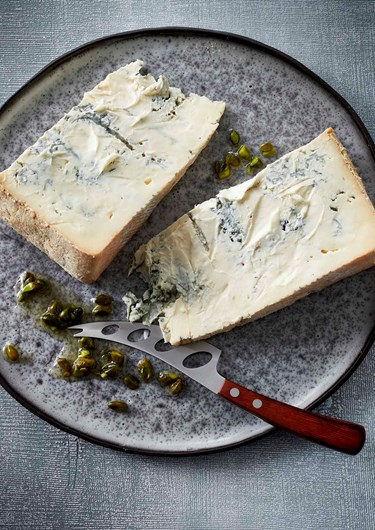
Gorgonzola
What is Gorgonzola?
Close to the borders of Italy, lush plains stretching beside knitted rivers and lakes dominate the landscape surrounding Gorgonzola. A province bound in Italian cuisine, it is home to its namesake: Gorgonzola cheese. Resembling archaic porcelain, this blue mould cheese spares little in the way of decadence and flavour. When young, it is soft and creamy, opening with nimble strokes of butter and slowly approaching a slightly acidic finish. Mature versions are stronger, piquant and deliver a pungent bite to finish.
On pastures spread across the regions of Lombardy and Piedmont, cows feed on natural forage, delivering unrestricted, full-bodied milk to the creameries. Originally thought to derive from the herded cows being exhausted, the unique flavours of Gorgonzola are still attributed to these regions.
With a distinct look, Gorgonzola is versatile in its uses, adding zest to risottos, pastas or pizzas. The white and blue marbling stands gracefully on a cheeseboard, pairing wonderfully with grapes, honey and pistachios.
Often referred to as blue cheese, Gorgonzola is exclusively made from cow’s milk, often boasting milder flavours than those of other blue cheeses. What truly sets it apart from other blue cheeses is its deep roots in Italian artisanship, still influencing production today.
How Gorgonzola is made
With a history shrouded in mystery, today Italian Gorgonzola is still made with passion and feeling - a hallmark of Italian cuisine.
Fresh milk from nearby pastures is delivered daily to the local creameries. Rigorous monitoring confirms the quality of the milk, ensuring it maintains its full-bodied flavours after pasteurisation. A mixture of carefully selected yeasts and rennet is added to the pasteurised milk, which is then transferred to large tanks, with the purpose of coagulating the milk and triggering the marbling effect. Shortly after this, the milk curdles to a firm paste. The curd is then cut and separated, allowing the whey to be released. Placed in moulds and brined with sea salt, the moulds are placed to age. During this process, the rind is pierced with steel needles, promoting the marbling within the body. After a minimum of 50 days spent maturing, the cheese is labelled Gorgonzola.
Traditional Gorgonzola is pasteurised and free of artificial fillers and gluten, but labels should always be checked in any case. Depending on the type of rennet, also be sure to check the label for any non-vegetarian ingredients.
Substitutes for Gorgonzola
Gorgonzola shares many of the traits seen in similar cheeses from other culinary cultures, with the level of intensity and sharpness often being the strongest difference.
Gentle, rich and smooth, Creamy Blue is graced by tones of mild bitterness followed by a soothing finish. It opens softly, gradually presenting its slightly sharp profile as it lingers. A delightful blend of zest and creaminess, Creamy Blue leaves a strong impression.
Another blue mould cheese named after its place of origin is Roquefort, made from sheep’s milk. Tangy, crumbly and with a unique marbling, this cheese closely resembles its Italian counterpart. Aromatic and pungent, Roquefort holds its own when used as a substitute for Gorgonzola.
Blue Stilton is another crumbly blue mould cheese. It is strong in taste and aroma, offering depth and a tangy finish.
Curious about the world of cheese? Here's everything you need to know about how to store, serve and cut cheese!




